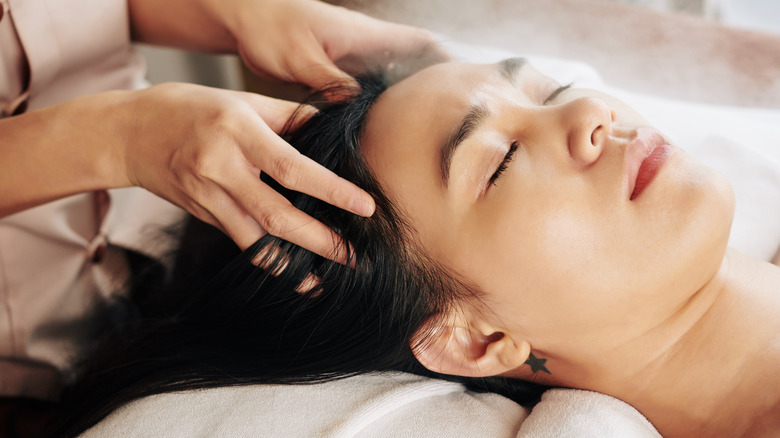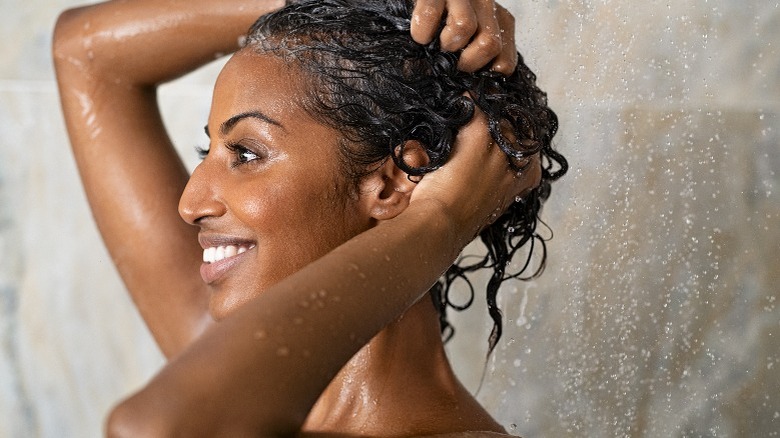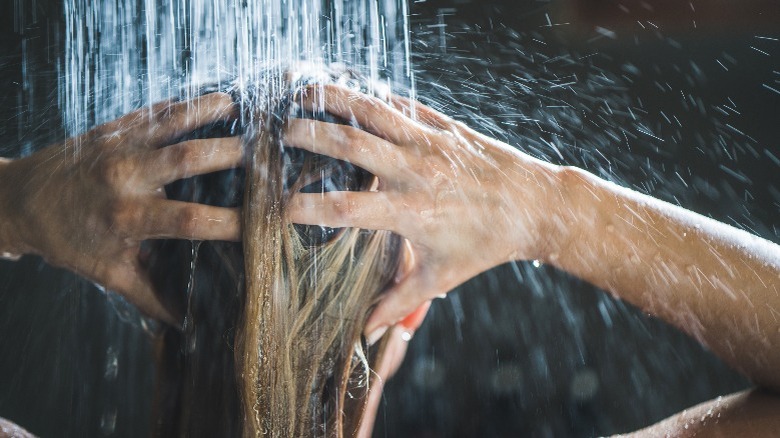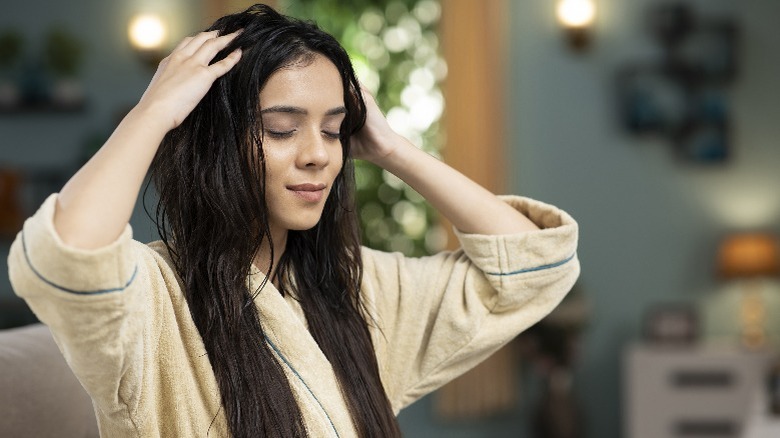'Hair Tapping': The Easiest Technique To Encourage Scalp Health And Hair Growth
A soothing head massage is easily one of the most scrumptious, relaxing sensations to experience, yet most of us rarely, if ever, are treated to a diligent rub of our scalps. If the sound of a scalp massage sounds enticing and you're dreaming of having your head kneaded right now, then you're in for a delectable treat. You now have expert-backed encouragement to give yourself a scalp massage every time you wash your hair. Should waiting for your next shower for such an indulgence seem too far away, the technique can be practiced outside of the shower as well. So what is this magic massage method with the potential to improve the health of your head and hair?
One technique of a head massage is called hair tapping, a dermatologist-recommended method that's made waves across social media. Laura Romero, a director for perfumery and luxury atelier brand Guerlain, as per Spanish Vogue, has been vocal about the cosmetic, health, and wellness benefits of the method involving specific tapping motions during shampooing. Healthline reports scalp massage and its relaxation effects are well known, with plenty of research on the benefits and drawbacks of both shower scalp kneading and dry head massage.
The beneficial trifecta of shower, shampoo, and hair tapping
According to WebMD, tapping has its roots in acupuncture, an ancient practice which focuses on the body's energy. Instead of using needles, tapping is more similar to acupressure in that you use your fingers. The basic guidelines for hair tapping are to spend a handful of mindful minutes in the shower practicing intentional massage of your scalp as you smooth shampoo through your strands. The method's namesake is quite literal in its description of how the technique should be performed, indicating that as hair is shampooed, hands and fingers should be used to tap the scalp in a massaging manner. It's believed that rapid tapping is most beneficial for the purported promises of hair growth and scalp stimulation.
Starting at the front of the hairline, frame the forehead with your fingers and work your way around to the nape of the neck. Quick tapping motions mimic a massage, simultaneously spreading shampoo through the hair for cleansing purposes while also providing soothing stimulation.
The rapid tapping on the scalp mimics a drumming motion, which can provide waves of physical relief by releasing tension in the head and neck. Proponents suggest massaging your scalp as usual and then ending with hair tapping. When done on dry hair, you can add products to your fingertips that reportedly enhance hair health and growth, such as those that contain rosemary or castor oil, according to Prevention.
Benefits of hair tapping include improved hair health and growth
Hair growth is a hefty promise promoted by the hair tapping technique. Now, it's unlikely you'll wake up the morning after performing hair tapping with hair like Rapunzel's extensive mane, but you should see improvements if you practice the method regularly, correctly, and with consistency. You'll also need to prioritize patience, as results will be subtle and occur over a prolonged period of time. But as they say, slow and steady wins the race — a 2016 study in the ePlasty journal concluded that regular scalp massage resulted in thicker hair due to increased follicle stimulation. It's this same stimulation that can encourage growth, per Healthline.
According to the Pacific College of Health and Science, it's the increased blood flow brought about by massaging the scalp that increases the nutrients in hair follicles. When you practice hair tapping in the shower, be sure to tap your fingertips across your entire scalp, imagining that you're covering each individual follicle.
Other methods to stimulate the scalp
In addition to hair tapping to improve the health of your hair and scalp, you can use tools like a scalp brush, specifically one with silicone bristles. According to Straand, the flexible material helps to exfoliate dead skin cells and reduce dandruff, resulting in a clear scalp, paving the way for better hair growth. Silicone brushes are more efficient at scalp exfoliation than our fingers. There's also the technique of hair pulling. No, not the condition known as trichotillomania. Instead, you gently tug on your hair as you massage. You shouldn't feel any pain while performing this technique.
Should you want a scalp massage during the day but are unable to hop into the shower, the shower-based scalp brush technique can be replicated on dry hair and head by running a hairbrush through your locks and focusing on contact with the scalp and hair follicles. Again, brushes with silicone bristles are best, particularly those designed for use as scalp therapy brushes.
A few minutes of massage can yield major benefits
Experts have been studying the benefits of head massage on various aspects of health, both physical and mental, and have confirmed time and time again that diligent, mindful massage movements provide positive benefits, even if the benefits are barely tangible. A 2018 study published in Alternative Therapies in Health and Medicine found that the brain increases production of relaxing and feel-good hormones such as oxytocin, with positive hormones increasingly released when another person massages your scalp or you massage someone else's head. Take this as your sign to ask your partner or best friend to give you a head massage.
Knowing that you can perform hair tapping or traditional kneading on dry hair as well as wet, you have a range of options for receiving the benefits of this method, including more hair growth, improved blood circulation, and a thicker head of healthy locks.



